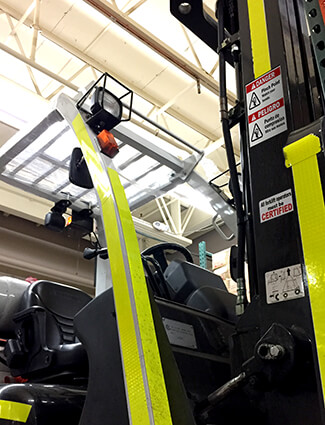Training, Communication Essential for Forklift Safety
03
February,
2023
2 MINUTE READ

Forklifts are an essential tool in workplaces these days. They help workers move more materials in less time. However, when workers who operate forklifts feel pressured for time, safety might become secondary, which can result in a costly mistake. Workplaces can stay on top of forklift safety through continuous training and education, and making sure communication is clear and efficient.
Drive Down Hazards
According to reports by OSHA and the Bureau of Labor and Statistics, each year, there are about 34,900 forklift accidents that result in serious injury or death. The primary causes of those casualties include vehicle tip-over, crushed by a vehicle, struck, or run over by a forklift, struck by material, or falls from the fork platform. In most of those incidents, there is one safety feature that was neglected: seat belts.
"The least favorite topic of operators is seat-belt usage," said Kyle Thill, vice president of operations at Toyota-Lift of Minnesota. "When a truck tips, the seat belt keeps the operator in his seat helping him/her avoid what is called the flyswatter affect. Without a seat belt, they often try to jump from the truck and are generally caught between the overhead guard and the ground."
"When a worker doesn't wear a seat belt, they might think they are saving time," said Phoebe Wang, a forklift specialist in Hefei, China. "Then there is an accident. You must pay attention. It's all in training and reminders."
Safety that Clicks
 Forklift safety training is not just a one-and-done event. While forklift operators carry most of the weight, forklift safety is everyone's responsibility in the workplace. Signs and labels help remind workers of proper procedures, important information, and vehicle working boundaries. Here are three important safety reminders forklift drivers should adhere to when operating a vehicle.
Forklift safety training is not just a one-and-done event. While forklift operators carry most of the weight, forklift safety is everyone's responsibility in the workplace. Signs and labels help remind workers of proper procedures, important information, and vehicle working boundaries. Here are three important safety reminders forklift drivers should adhere to when operating a vehicle.
- Lifting: Remind workers to follow safe operating procedures. Post load lift limits, seat belt reminders, and tip-over safety instructions. Make sure employees understand forklift rules and know there is no harm in asking for help or asking questions.
- Visibility: In many warehouse incidents, insufficient lighting is responsible. Workers should make sure they have adequate lighting and visibility to conduct the tasks they need on a forklift, even in inclement weather. Objects that are not where they belong can also attribute to forklift safety challenges. Be sure workers on or around forklifts do not have objects blocking visibility or pathways.
- Hazardous materials: Failing to follow requirements for hazardous material handling or not wearing personal protective equipment is a common cause of injury. Hazard communication is consistently on the OSHA list of top violations.
The best way to reinforce forklift safety training is through supportive safety messages, both on the forklift itself and throughout the workplace. Start with a facility walk-through before forklift operations. Conduct routine forklift and workspace evaluation for thorough hazard mitigation, including ensuring seat belts are in good working condition. Be sure signs and labels are not peeling or cracking so that workers can read forklift operation expectations. Reinforce walking, working, and forklift traffic safety through high-visibility signs, labels, and floor marking. A facility that is clean, organized, and uses quality visual communication shows all workers that the facility values its work environment and workers.
Identify areas for improvement with convenient safety checklists in our free Warehouse Efficiency Guide.
RELATED RESOURCES

Prepare for National Forklift Safety Day
National Forklift Safety Day is the second Tuesday in June. The day serves as a focal point for manufacturers ...
Read
End the Chaos: Easy, Smart Forklift Traffic Safety
Forklifts and pedestrians in a busy workplace can sometimes lead to accidents. Yet, there are other important ...
Read
Easy Ways to Enhance Loading Dock Safety
Warehouses are busy work environments. Keep loading dock workers moving efficiently and safely using these ...
Read.png)


